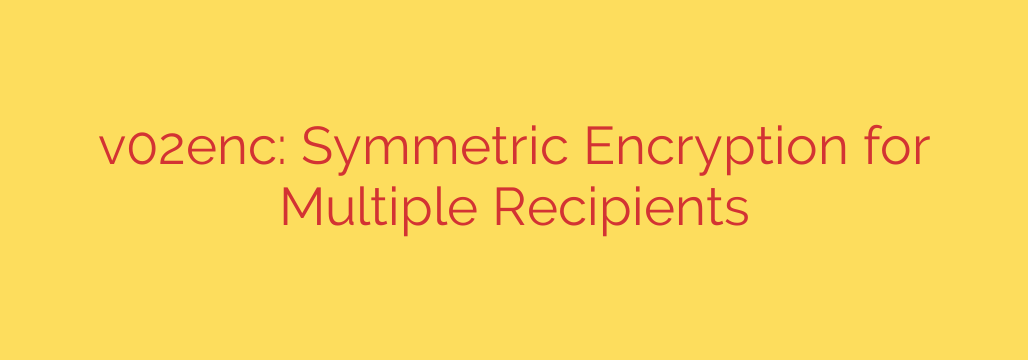
Encrypt Once, Share Securely with Many: A Guide to Multi-Recipient Encryption
Sharing sensitive information with a group is a common challenge. Whether you’re sending a confidential report to a project team or distributing private data to multiple stakeholders, ensuring that only the intended recipients can access it is critical. However, traditional encryption methods often fall short when more than one person is involved.
You might be tempted to encrypt the file separately for each person, but this is incredibly inefficient, creating massive files and consuming significant processing power. The alternative—creating a single shared password or key for the group—is a major security risk. If that single key is ever compromised, the entire group’s security is breached, and revoking access for just one person becomes a logistical nightmare.
Fortunately, there’s a modern, elegant solution that combines robust security with high efficiency: envelope encryption. This method allows you to encrypt a file once and securely share it with any number of recipients, without the drawbacks of older techniques.
The Problem with Traditional Group Encryption
Before diving into the solution, it’s important to understand why the old ways are problematic:
- The Brute-Force Method (Encrypt-for-Each): Encrypting a 1GB file for ten people means you are performing ten separate, resource-intensive encryption operations and creating a final package that is over 10GB in size. This simply doesn’t scale.
- The Shared Secret Dilemma: Using one password for everyone creates a single point of failure. If one person’s account is compromised or they leave the team, you must re-encrypt the data with a new key and redistribute it to everyone remaining, a clumsy and error-prone process.
These methods force a choice between efficiency and security. Modern cryptography says you don’t have to choose.
The Modern Solution: How Envelope Encryption Works
Envelope encryption is a powerful hybrid approach that uses both symmetric and asymmetric cryptography to get the best of both worlds. The core idea is simple: you don’t encrypt the large data file for each person. Instead, you encrypt the key for each person.
Here’s a step-by-step breakdown of the process:
Generate a One-Time Data Key: First, a new, unique, and highly random symmetric key is generated. This is called the Data Encryption Key (DEK). This key will only be used to encrypt the actual file.
Encrypt the Data Once: The large data file is encrypted just one time using the DEK and a strong symmetric cipher like AES-256-GCM. This process is extremely fast and efficient, as symmetric encryption is optimized for handling large amounts of data.
Create Recipient “Envelopes”: Now, for each intended recipient, you take the DEK and encrypt it using that specific person’s public key (part of their public/private key pair). This creates a small, individually encrypted “wrapper” or “envelope” containing the DEK. Because the DEK is very small (e.g., 32 bytes), this asymmetric encryption step is incredibly fast.
Package and Send: The final message consists of two parts: the single, large encrypted data block and a list of the small encrypted “envelopes.” The entire package is then sent to the group.
When a recipient receives the file, they use their unique private key to open only their specific envelope. This reveals the DEK, which they can then use to decrypt the main data file. If their private key can’t open any of the envelopes, they can’t access the data.
The Key Benefits of This Approach
This multi-recipient encryption strategy offers significant advantages over traditional methods:
Unmatched Efficiency: The most computationally expensive task—encrypting the main data—is only performed once. This saves massive amounts of CPU time and results in a final file size that is only slightly larger than the original encrypted data, regardless of whether you have 10 or 1,000 recipients.
Robust, Granular Security: There is no shared secret. Each recipient’s access is tied directly to their own private key. If one recipient’s key is compromised, it does not affect the security of any other recipient. Access is completely compartmentalized.
Scalability and Flexibility: Adding a new recipient is as simple as creating one more encrypted envelope with their public key and adding it to the list. Revoking access is also straightforward—simply re-encrypt the data without creating an envelope for the person being removed.
Actionable Security Tips for Implementation
When implementing or using systems based on this model, always adhere to security best practices:
- Use Strong Cryptography: Ensure the system uses modern, well-vetted cryptographic algorithms. For example, X25519 for key exchange and AES-256-GCM for symmetric encryption are industry standards for high security and performance.
- Protect Your Private Keys: The entire security model depends on the secrecy of each recipient’s private key. These keys must be stored securely, ideally in a hardware security module (HSM), a secure enclave, or protected by a strong passphrase.
- Use Trusted Libraries: Don’t roll your own crypto. Implement this model using well-maintained, peer-reviewed cryptographic libraries like libsodium or Tink to avoid common implementation pitfalls.
- Verify Recipient Identities: Before encrypting a key for a recipient, ensure their public key truly belongs to them, typically through a trusted public key infrastructure (PKI) or a web-of-trust model.
By moving beyond outdated methods and embracing a modern strategy like envelope encryption, you can ensure your sensitive data remains confidential, accessible only to those you trust, without sacrificing efficiency or scalability.
Source: https://www.linuxlinks.com/v02enc-symmetric-encryption-for-multiple-recipients/








